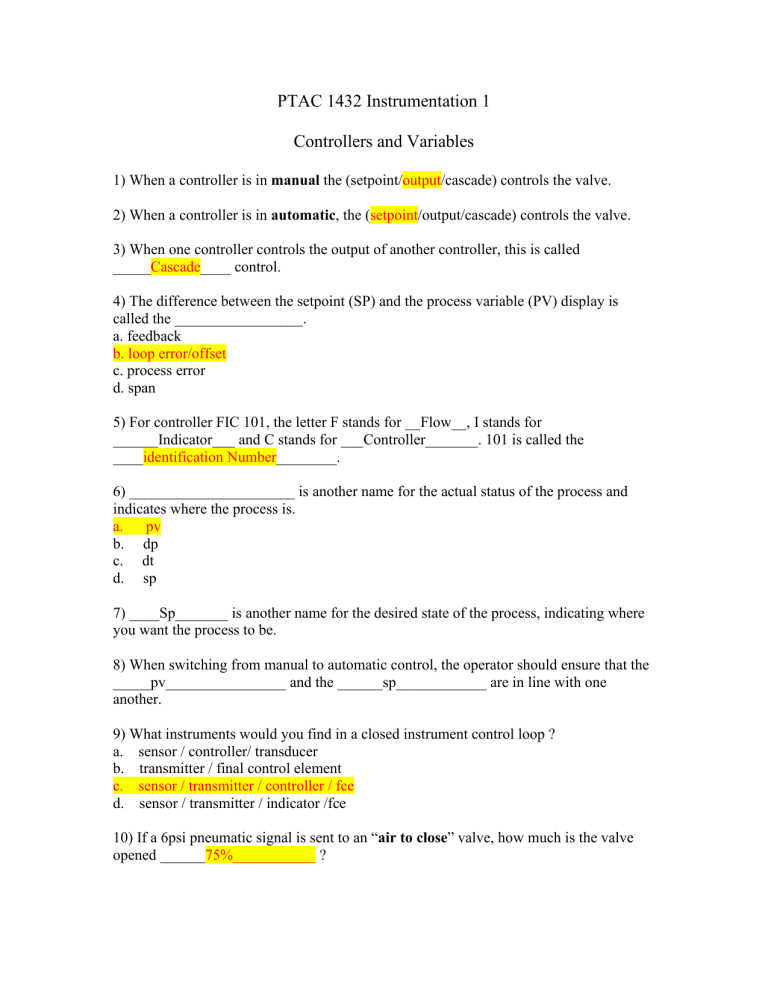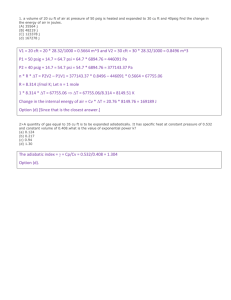Instrumentation & Control Worksheet: Controllers, Variables, P&IDs
advertisement

PTAC 1432 Instrumentation 1 Controllers and Variables 1) When a controller is in manual the (setpoint/output/cascade) controls the valve. 2) When a controller is in automatic, the (setpoint/output/cascade) controls the valve. 3) When one controller controls the output of another controller, this is called _____Cascade____ control. 4) The difference between the setpoint (SP) and the process variable (PV) display is called the _________________. a. feedback b. loop error/offset c. process error d. span 5) For controller FIC 101, the letter F stands for __Flow__, I stands for ______Indicator___ and C stands for ___Controller_______. 101 is called the ____identification Number________. 6) ______________________ is another name for the actual status of the process and indicates where the process is. a. pv b. dp c. dt d. sp 7) ____Sp_______ is another name for the desired state of the process, indicating where you want the process to be. 8) When switching from manual to automatic control, the operator should ensure that the _____pv________________ and the ______sp____________ are in line with one another. 9) What instruments would you find in a closed instrument control loop ? a. sensor / controller/ transducer b. transmitter / final control element c. sensor / transmitter / controller / fce d. sensor / transmitter / indicator /fce 10) If a 6psi pneumatic signal is sent to an “air to close” valve, how much is the valve opened ______75%___________ ? 1) ___True ___False A 100% proportional band control requires a 100% change in input to get 100% change in output in output. 2) Integral (reset action) is a function of __Time_____ required to complete (or repeat) a corrective action. 3) Derivative (rate action) determines the ___Rate of change__________ of corrective action that’s needed to stabilize the process variable. 4) A primary controller that works in conjunction with a secondary controller within a instrument control loop is called a ____Cascade_________ control loop. 5) Using a 50% proportional band setting; for every 10% input change causes a _____20________% change in output. 6) Give an example of a split-range controller ____________________ Valve A ___3-9psi_____________________________________________ Valve B ___9-15psi____________________________________________. 7) Explain the term “bumpless transfer ”____setting pv == sp without changing the output______________________ ? 8) What’s the difference between a direct acting controller and a reverse acting controller ___if you increase the input the output also increases for direct acting where as reverse acting controller does the opposite of input during output_______________________ ? 9) A 2% ratio controller setting of water to feed mixture would require ______2000_______gallons of water for every 100K gals. of feed. 10) What instruments devices are upstream and downstream of the controller in a instrument control loop ______transmitter________________ and __________transducer/FCV____________? Pressure Conversions: (1 psi=27.7 in.H2O / 1 psi = 2.04 in.Hg) 1. 5.00 psi = ___138.5____________ inches of water. 2. 3.00 psi = ___83.1____________ inches of water. 3. 90 inches of H2O =____3.24_______ psi. 4. 85 inches of H2O =____3.06__________psi. 5. 12 psi =_____24.48__________in. Hg. 6. 6 psi =_______12.24_________in. Hg. 7. 25 in. Hg = ____12.25__________psi. 8. 14 in. Hg =_____6.86_________psi. psia to psig conversions: 9. 3.0 psia = ______-11.7_________psig. 10. 15.7 psig = _____30.4_________psia. 11. 29.2 psig = _____43.9_________psia. 12. 39.7 psia = ______25________psig. 1. A ____Manometer___________ is one of the oldest pressure gauge devices still in use today that’s U-shaped so that fluid flows freely between the chambers. 2. A ____Vacuum__________ is where the pressure measured is less than atmospheric pressure. 3. ____T ____F A major source of pressure exerted by liquids (and solids) is gravity. 4. ____T ____F A major source of pressure exerted by gases is heat. 5. ___Density___________ is defined as mass per unit volume. 6. One cubic ft of water weighs_____62.41 lbs___________. 7. How much pressure is exerted (psig) by one cubic ft of water___0.433__ ? 8. ___T ____F Specific gravity is the density of a material relative to the density of water. 9. Pressure is defined as force divided by _____Area____________. 10. If the force goes up, then the pressure goes ___Up_________. 11. If the area goes up, then the pressure goes ___Down____________. 12. Atmospheric pressure at sea level is _____0__________ psia. 13. If a person travels to the highest mountains, the atmospheric pressure would be (higher / lower) than at sea level. 14. ___T ___F On the psig scale, zero represents atmospheric pressure. 15. What’s the head pressure (psig) at the bottom of a tank that hold 5ft of a material with a specific gravity of 0.85 Answer ____1.84____ psig. 16. What’s more dangerous if a vessel ruptures: 1) a tank filled with liquid or 2) a tank filled with gases. Both tank pressures read 1,000 pounds psig. _______Gas___________ (The liquid is water & the gas is air). 1. How much head pressure is exerted by 6ft of a liquid material with a specific gravity of 1.2 in an opened tank ? Answer inches of water) P = h * sg P = 12*6 *1.2 == 86.4 inches of water 2. How much pressure does 10 ft of liquid with a sg of 0.8 produce if it’s in a closed vessel with 5 psi of nitrogen pressure on top ? P= h*sg P = 10*12*0.8 = 96 inches of water PSI = 96/27.77 == 3.46 PSI +5 PSI of nitrogen == 8.46 PSI 3. A pressure gauge (psig) is located 4ft from the bottom of an open tank that has a level of 12 ft in it and the sg of the material is 1.1 What does the gauge read ? P= h*sg P = 8*12*1.1 = 105.6 inches of water PSI == 105.6/27.7 = 3.81 PSI 4. How much head pressure is exerted by 8 ft of a liquid material with a specific gravity of 1.2 in an opened tank? P=h*sg P = 8*12*1.2 = 115.2 PSI = 115.2/27.7 = 4.16 PSI 1) The type of diagram that shows the flow scheme in a sequential block form is called a ___Block flow Diagram ________________. 2) A ___Process Flow Diagram________ pictorially indicates the general flow of the process (using symbols ) including the major process equipment but does not show the minor details such as instrumentation control loops. 3) A ___Process and instrumentation diagram_______shows the inter-connecttion of the process equipment and the instrumentation used to control the process. 4) _____ T _____ F Instrument identification (tag numbers) use both letters and numbers to uniquely describe instruments on a unit. 5) The first letter ( LIC 100) indiactes which process ___Variable_______ is being measured. The letter ( I ) stands for ____Indication ______ & ( C ) stands for _Succeeding _______. 6) The symbol ( AAH ) stands for ___Analyzer Alarm High______________________________. 7) In a remote balloon symbol, the letters identifying the instrument should be placed at __High_______ portion of the ballon and the number should be placed at the ____Low_______ part of the balloon, 8) What is the purpose of a legend on a P & ID ? _____tell us signal and energy that is being used_____________. 9) A _____Mechanical Flow Diagram___ shows mettalurgy, line sizes and flange rating. 10) An ___ISO__________ drawing is in 3-D form. 11) ____ T ____ F Cross hatching on a P & ID denotes a revision. 12) _____ T _____ F A P & ID should do at least 4 things: a. have unique identification number b. show connection between instruments c.show location of instrument d. describe the function of the instrument



